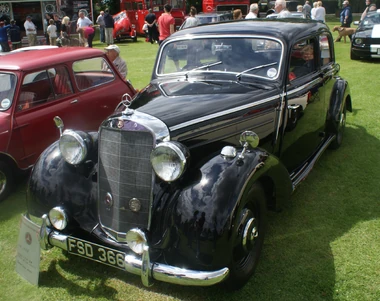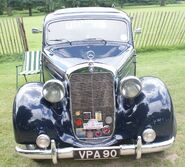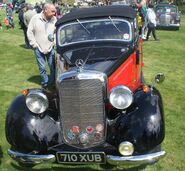
Mercedes-Benz 170
The Mercedes-Benz W136 (and similar W191) was Mercedes-Benz's line of four-cylinder automobiles from the mid-1930s into the 1950s. It became the foundation on which the company rebuilt after World War II because the tooling had survived Allied bombing.
From May 1949 the car was offered with an exceptionally economical 38 PS (28 kW; 37 hp) diesel engine. This was the world's third diesel fueled passenger car, and the first to be introduced after the war.
The Mercedes-Benz 170 SV and 170 SD were also built briefly in Argentina from 1953-1955 in sedan, taxi, station wagon, pick-up and van versions.
Mercedes-Benz 170V[]
Mercedes-Benz W136 is the name, using the manufacturer's works number, under which the car is frequently known in retrospect, but the car introduced early in 1936 was known as the Mercedes-Benz 170V. It replaced the six cylinder Mercedes-Benz W15, which at the time had also been known as the Mercedes-Benz 170. Despite having a similar engine capacity of 1.7 litres, the new car's four cylinder unit was more powerful. Technically and stylistically it was far more modern and could be sold at a lower price. Between 1936 over 75,000 were built making it by far the most popular Mercedes-Benz model up till that point.
The "V" in the 170V's name was short for "Vorn" (front) and differentiated the car from the contemporary Mercedes-Benz 170H (where "H" was short for "Heck" or rear) which used the same four cylinder 1697cc engine, but positioned at the back of the car.
Claimed maximum power output was 28 kW (38 PS) at 3,400, using a compression ratio (during the car's early years) of 6:1. The side-valve four cylinder engine consumed fuel at the rate of less than 10 litres per 100 kilometres (28 mpg-imp; 24 mpg-US). The motor was attached using just two mountings and ran with a smoothness hitherto unknown in a four cylinder unit.
Power was delivered to the rear wheels via a four speed manual transmission which initially came with synchromesh only on the top two ratios. However, in 1940 the transmission was upgraded after which synchromesh was incorporated for all four forward ratios. [1][2]Mercedes-Benz 170D OTP "Police special" (1951-1952)==Bodywork options== Most of the cars produced, and an even higher proportion of those that survive, were two or four door "Limousine" (saloon/sedan bodied cars, but the range of different body types offered in the 1930s for the 170V was unusually broad. A four door "Cabrio-Limousine" combined the four doors of the four door "Limousine" with a full length foldaway canvas roof.
Both the foor door bodies were also available adapted for taxi work, with large luggage racks at the back. There was a two door two seater "Cabriolet A" an two two door four seater "Cabriolet B" both with luggage storage behind the seats and beneath the storage location of the hood when folded (but without any external lid for accessing the luggage from outside the car). A common feature of the 170V bodies was external storage of the spare wheel on the car's rear panel.
The two seater roadster featured a large flap behind the two seats with a thinly upholstered rear partition, and which could be used either as substantial luggage platform or as a very uncomfortable bench - the so-called mother-in-law's seat.
In addition to the wide range of passenger far bodied 170Vs, a small commercial variant was offered, either as a flatbed truck or with a box-body on the back. Special versions of the 170V were offered, adapted for use as ambulances or by the police, mountain rescue services and military.
After the war[]
During the war the Mercedes-Benz plant suffered very severe bomb damage, but the manufacturer nevertheless emerged from the trauma of war with a significant competitive advantage over many of its pre-war competitors. Manufacturers including Adler, BMW and Ford in Germany had been heavily dependent for the supply of steel car bodies on Ambi-Budd whose Berlin plant was destroyed by bombing in 1943: its site now ended up in the Soviet occupation zone (subsequently East Germany). The manufacturing plants of Horch, Wanderer and BMW were located in what in July 1945 became the Soviet controlled part of Germany. None of these manufacturers could resume volume production without first finding a way to obtain and fund a source of steel car bodies and access to a suitable plant for auto-assembly. Mercedes-Benz, however, retained ownership of and access to its car plant.
Production restarted in May 1946. The vehicles produced were versions of the 170V, but in 1946 only 214 vehicles were produced and they were all light trucks or ambulances. Passenger car production resumed in July 1947, but volumes were still very low, with just 1,045 170Vs produced that year. There was no return for the various open topped models from the 1930s. Customers for a Mercedes-Benz 170V passenger car were restricted to the four door "Limousine" sedan/saloon bodied car.
Production did ramp up during the next couple of years, and in 1949 170V production returned to above 10,000 cars. From May 1949 the car, badged in this permutation as the Mercedes-Benz 170D, was offered with an exceptionally economical 38 PS (28 kW; 37 hp) diesel engine. The 170D was the world's third diesel fueled passenger car, and the first to be introduced after the war.
Police "special"[]
In 1951 and 1952 Mercedes-Benz produced a version of the car known as the 170 D OTP for police use. The was effectively a four door cabriolet, although the hood was of rather a thin material and basic structure when compared to the 170 cabriolets of the 1930. It was a requirement that all the cars should be painted in "Police Green", but in the end most of the cars delivered to the police were painted blue. Although the car was provided only for the use of official bodies, it incorporated several technical and other features, including for the first time on a 170 car a trunk/boot accessible from the outside via a hinged lid, which soon afterwards appeared on other upgraded W136s.
1950 upgrade[]
In May 1950 the 170V and 170D received a power upgrade thanks to a larger engine. They now used the 1767cc units which would, in 1953, go on to power the Mercedes-Benz 180. At this stage there was no name change to reflect the increased engine size. At the same time safety was improved with the incorporation of telescopic shock absorbers, a wider rear track, and stronger brakes. Attention in this upgrade was also applied to comfort with the passenger cabin widened by 50 mm (2.0 in) and larger seats. The luggage compartment at the back finally became accessible from outside, using a boot/trunk lid and ventilation was improved. To differentiate them from the existing models, the petrol/gasoline and diesel versions of the upgraded cars were designated internally as the Mercedes-Benz 170 Va and Mercedes-Benz 170 Da.
1952 upgrade[]
A further upgrade took place in May 1952, accompanied by new suffixes for the name. The Mercedes-Benz 170 Vb and Mercedes-Benz 170 Db now featured new single piece bumpers. The rear track was widened by a further 18 mm (0.71 in). The two rows of vertical ventilation slats that had till now adorned the sides of the bonnet/hood were replaced by a pair of horizontal slats on each side. The windscreen wipers which had hitherto been attached at the top of the windscreen frame were now attached at the bottom, the screen itself also having been slightly, if imperceptibly, enlarged.
The 170 Vb and 170 Db remained in production for just over a year, till August 1953,
1953 upgrade[]
With the appearance of the new Ponton bodied Mercedes-Benz 180 in 1953, the 170 models suddenly appeared very old fashioned. The 170 V was delisted in September 1953: in July 1953 the manufacturer had replaced the existing 170 S with the reduced specification 170 S-V. The car that resulted combined the slightly larger body from the 170 S with the less powerful 45 PS engine that had previously powered the 170 V. The vehicle provided reduced performance but at a reduced price, while salesmen steered more prosperous buyers to the new Ponton bodied 180. The diesel powered 170 S continued to be sold, now branded as the 170 S-D. The internal “W191” designation which had distinguished the previous 170Ss was removed, and the 170Ss manufactured from 1953 returned to the “W136” works designation that they had shared with the 170 V till the end of 1951.
In September 1955 the last Mercedes-Benz W136, the Mercedes-Benz 170 S was withdrawn from production.
Models[]
- 1935–1942: 170 V sedan/cabriolet
- 1946–1950: 170 V sedan/cabriolet
- 1949–1952: 170 S/SAC/SBC
- 1950–1952: 170 Va
- 1952–1953: 170 Vb
- 1953–1955: 170 S-V/S-D
- 1949–1950: 170 D
- 1950–1952: 170 Da/DaOTP
- 1952–1953: 170 Db
- 1952–1953: 170 Sb
- 1952–1953: 170 DS



